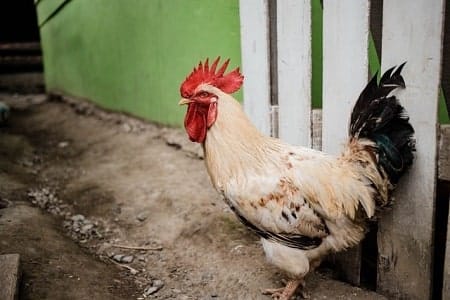Today we’re talking about those red things on the top of chicken’s heads that come in all shapes and sizes - combs.
More specifically, whether or not all chickens have combs. As well as how combs differ between roosters and hens, why chickens have combs, and of course, look at some cool-looking combs.
Table of Contents
Do All Chickens Have Combs?
All chickens do have combs, yes. Some develop combs later than others, some have small pea or rose combs, and sometimes it’s hard to see the comb - but all roosters and hens do have combs.
I’ve certainly never seen a chicken without a comb (that hadn’t been removed). I searched hard and asked around if anyone else had, and was not able to find any evidence of there being a breed of chicken that is comb-less.
Some breeds do have small combs, and some are even well hidden by ‘crests’ of feathers though. So, if you’ve seen a chicken and didn’t think they had a comb, it may be due to one of those reasons.
At What Age Do Chickens Get Their Combs?
If you see a chicken without a comb, it may be because the chicken has not developed their comb yet. The age at which a chick develops a comb varies a lot depending on the breed, but generally speaking, it will be at least 6 weeks before you see a little red comb emerging.
You’ll know just by looking at a chicken if they’re chicks, pullets, or not fully matured, so this one should be fairly obvious.
Removing Chickens' Combs and Wattles "Dubbing"
I also want to touch on the topic of ‘dubbing’. Dubbing is the process of removing a chicken’s comb, wattle, or both. So, if you see an adult chicken missing a comb or wattle, this may be the reason.
Dubbing isn’t common these days, especially not in the backyard community. Traditionally, dubbing a chicken is performed to prevent damage to their combs and wattles from freezing temperatures and fighting.
In commercial settings where chickens have a lot less space, pecking and fighting within a flock is a lot more prevalent.
Some chicken farms may cut off their combs at an early age to prevent damage. It really doesn’t address the larger issue of keeping so many hens in close proximity, but that’s a controversial topic that I will not be going into here.
Related - When is the right age to dub a rooster? (Reasons and ages explained)
Can You Trim a Chickens Comb?
It’s not that uncommon for a chicken to injure, tear, or show signs of disease on its comb. Especially if they have a large single comb with big spikes.
Combs typically do not repair themselves very well. If you ever see a chicken with a damaged comb, it’s likely to have been like that for a while and will continue to stay like it.
This leaves the chicken open to infection, being picked on and pecked at by its flock mates, and let’s be honest, it’s just not nice to see them with flapping bits of comb on their heads.
For these reasons, it’s common for avian vets - or even owners - to trim damaged combs.
This is a procedure best left to a vet if you’re not experienced in doing minor procedures on animals. Chickens have feelings in their combs, so it’s going to cause some pain and potentially be stressful.

Why Do Chickens Have Combs?
The reasons why chickens have combs have been debated for a long time and really come down to the best scientific guess as it’s not 10% obvious.
The primary function of a comb and wattle is believed to be as a ‘cooling system’. There is warm blood flowing through both the comb and wattle, and it’s believed that as blood flows through these external body parts, it cools slightly.
This makes perfect sense. It’s not too dissimilar to how rabbits use their long thin ears to cool down, and seeing as chickens can’t sweat they need a little extra help.
Another thing to note is that a chicken’s comb is a good indication of their overall health. When a chicken is sick, one of the first signs will be a floppy or pale comb.
If you notice anything different about your chickens’ combs, it’s definitely something worth investigating.
Related - How do chickens cool themselves down?
Do Hens and Roosters Have Different Combs?
The comb itself is the same on both hens and roosters in that it performs the same function, feels the same, and looks the same.
There are some subtle differences from an early age though, and it’s usually one of the earliest signs if a chick is male or female.
Male chickens (roosters) typically have larger, redder combs. They will develop slightly quicker, often be more upright, and it’s usually obvious if you have a female and male chick side-by-side.
When fully mature, a roosters comb is almost always going to be larger than a hen of the same breed.
In Summary
There you have it, chickens’ combs come in various shapes and sizes - but all chickens do have combs.
Combs, and wattles for that matter, provide some important functions. They are great general indicators of the chicken’s health, and they help regulate their core temperature by allowing warm blood to cool as it flows through their fleshy red bits.
Plus, it’s hard not to talk about combs without mentioning that they look pretty cool most of the time!
Resources
Image credits - Header photo by Max Kleinen, rooster by hannah grace on Unsplash




